Related Research Articles

A battle is a combat in warfare between two or more armed forces. A war usually consists of multiple battles. In general, a battle is a military engagement that is well defined in duration, area, and force commitment. An engagement with only limited commitment between the forces and without decisive results is sometimes called a skirmish.

Combined arms is an approach to warfare which seeks to integrate different combat arms of a military to achieve mutually complementary effects. According to strategist William S. Lind, combined arms can be distinguished from the concept of "supporting arms" as follows:
Combined arms hits the enemy with two or more arms simultaneously in such a manner that the actions he must take to defend himself from one make him more vulnerable to another. In contrast, supporting arms is hitting the enemy with two or more arms in sequence, or if simultaneously, then in such combination that the actions the enemy must take to defend himself from one also defends himself from the other(s).
Military doctrine is the expression of how military forces contribute to campaigns, major operations, battles, and engagements.

In military operations, reconnaissance or scouting is the exploration outside an area occupied by friendly forces to gain information about natural features and other activities in the area.
In modern use, the order of battle of an armed force participating in a military operation or campaign shows the hierarchical organization, command structure, strength, disposition of personnel, and equipment of units and formations of the armed force. Various abbreviations are in use, including OOB, O/B, or OB, while ORBAT remains the most common in the United Kingdom. An order of battle is distinct from a table of organisation, which is the intended composition of a given unit or formation according to the military doctrine of its armed force. Historically, an order of battle was the order in which troops were positioned relative to the position of the army commander or the chronological order in which ships were deployed in naval situations.

The battle of Dak To in Vietnam was a series of major engagements of the Vietnam War that took place between 3 and 23 November 1967, in Kon Tum Province, in the Central Highlands of the Republic of Vietnam. The action at Đắk Tô was one of a series of People's Army of Vietnam (PAVN) offensive initiatives that began during the second half of the year. PAVN attacks at Lộc Ninh, Song Be and at Con Thien and Khe Sanh,, were other actions which, combined with Đắk Tô, became known as "the border battles". The post hoc purported objective of the PAVN forces was to distract American and South Vietnamese forces away from cities towards the borders in preparation for the Tet Offensive.
AirLand Battle was the overall conceptual framework that formed the basis of the US Army's European warfighting doctrine from 1982 into the late 1990s. AirLand Battle emphasized close coordination between land forces acting as an aggressively maneuvering defense, and air forces attacking rear-echelon forces feeding those front line enemy forces. AirLand Battle replaced 1976's "Active Defense" doctrine, and was itself replaced by the modern "Full Spectrum Operations".

The Battle of El Guettar was a battle that took place during the Tunisia Campaign of World War II, fought between elements of the Army Group Africa under General Hans-Jürgen von Arnim, along with Italian First Army under General Giovanni Messe, and U.S. II Corps under Lieutenant General George Patton in south-central Tunisia. It was the first battle in which U.S. forces were able to defeat the experienced German tank units, but the followup to the battle was inconclusive.
Maneuver warfare, or manoeuvre warfare, is a military strategy which attempts to defeat the enemy by incapacitating their decision-making through shock and disruption.

The Battle of Hamburger Hill was a battle of the Vietnam War that was fought by U.S. Army and Army of the Republic of Vietnam (ARVN) forces against People's Army of Vietnam (PAVN) forces from 10 to 20 May 1969 during Operation Apache Snow. Although the heavily fortified Hill 937 was of little strategic value, U.S. command ordered its capture by a frontal assault, only to abandon it soon thereafter. The action caused a controversy both in the American military and public.

The Battle of 73 Easting was fought on 26 February 1991, during the Persian Gulf War, between the armoured forces of the United States as well as the 1st Armoured Division of the United Kingdom and those of the Iraqi Republican Guard and its Tawakalna Division. It was named for a UTM north-south coordinate line in the featureless desert that was used as a phase line to measure progress of the offensive as they were going through what the Iraqis thought was trackless desert. The battle was later described in a documentary as "the last great tank battle of the 20th century." This battle took place several hours after another, smaller, tank battle known as the Battle of Al Busayyah.
Principles of war are rules and guidelines that represent truths in the practice of war and military operations.
Force concentration is the practice of concentrating a military force so as to bring to bear such overwhelming force against a portion of an enemy force that the disparity between the two forces alone acts as a force multiplier in favour of the concentrated forces.

In military tactics, a flanking maneuver, or flanking manoeuvre is a movement of an armed force around a flank to achieve an advantageous position over an enemy. Flanking is useful because a force's offensive power is concentrated in its front. Therefore, to circumvent a force's front and attack a flank is to concentrate offense in the area where the enemy is least able to concentrate defense.
Military swarming is a battlefield tactic designed to maximize target saturation, and thereby overwhelm or saturate the defenses of the principal target or objective. On the other-hand, defenders can overcome attempts at swarming, by launching counter-swarming measures that are designed to neutralize or otherwise repel such attacks.

NLF and PAVN battle tactics comprised a flexible mix of guerrilla and conventional warfare battle tactics used by the Main Force of the People's Liberation Armed Forces and the NVA to defeat their U.S. and South Vietnamese (GVN/ARVN) opponents during the Vietnam War.
In United States military doctrine, unconventional warfare is one of the core activities of irregular warfare. Unconventional warfare is essentially support provided by the military to a foreign insurgency or resistance. The legal definition of UW is:
Unconventional Warfare consists of activities conducted to enable a resistance movement or insurgency to coerce, disrupt or overthrow an occupying power or government by operating through or with an underground, auxiliary or guerrilla force in a denied area.

Operation Thunderbolt, also known in China as the Defensive Battle of the Han River Southern Bank, was a US offensive during the Korean War.

The Siege of Myitkyina was an engagement during the Burma Campaign of World War II. The Allied victory was part of the larger operation of North Burma & Yunnan which succeeded in opening the Ledo Road.
References
This article includes a list of references, related reading or external links, but its sources remain unclear because it lacks inline citations .(September 2020) (Learn how and when to remove this template message) |
- US Department of Defense Dictionary
- Headquarters, Department of the Army (14 June 2001). FM 3–0, Operations. Washington, DC: GPO. OCLC 50597897. Archived from the original (PDF inside ZIP–SFX) on 19 February 2002. Retrieved 19 August 2013.